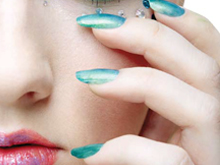 |
Take a good look at your nails and see if you see any ridges, pits or spots? Are they brittle? Are they yellowish and slow growing? Are they half white and half pink or even red at the base maybe? |
Most of us consider nails as dead tissue and take care of them for pure vanity. We groom them, manicure them, decorate them, polish them, just to make our hands and feet look attractive and it gives us the “oh so well maintained lookâ€. But there is more to nails than just vanity. Hippocrates in 400 BC believed and taught that nails reflect the inner health condition of a person. Nails protect and support the tissues our fingers and toes, yet most of us are ignorant that their quality, colour and texture reveal a lot about our underlying health condition.
A nail should generally be a healthy pink colour. Some common imperfections which are usually ignored are:
- White spots: This is usually caused by trauma to the nail, but could also be due to vitamin or mineral deficiency, especially iron and zinc.
- Pitting: These are small depressions in the nail plate and are associated with psoriasis and eczema.
- Brittle nails: Generally associated with iron deficiency and biotin deficiency but may be indicative of kidney disorder, thyroid or circulation problems. Also seen in Raynaud disease and gangrene.
- Ridges: Ridges can appear vertically or horizontally. Horizontal lines are called Beau lines usually caused by severe illness, stress or trauma. Vertical lines are indicative of psoriasis, skin infection and alopecia.
- Thick, distorted nails: Signify fungal infection.
- Excessively flexible nails: May signify deficiency of calcium and sometimes protein.
- Pale or white nails: Anaemia, and in severe cases of iron deficiency, lead to spoon-shaped nails.
- Terry’s (White) nails: Associated with liver disease, diabetes mellitus, congestive heart failure, and malnutrition.
- Bluish nails: Usually caused by lack of oxygen, indicate circulatory problems, heart and lung problems or blood toxicity.
- Yellow nails: Due to lymphatic obstruction, sinusitis, rheumatoid arthritis, nephrotic syndrome, thyroiditis, tuberculosis, Raynaud’s disease, vitamin E deficiency, poor circulation, liver problems, respiratory problems, diabetes, fungal infection, or prolonged use of nail polish without a base coat.
- Red nail bed: Indicates heart disease
- Half white, half pink nails: May signal kidney disease.
So be it long or short, groomed or uncared for, nails do offer warning signs of malnutrition, infection and underlying disease. The next time you visit your doctor, ask him to take a look at your nails, because healthy nails reveal a healthy you. |
|